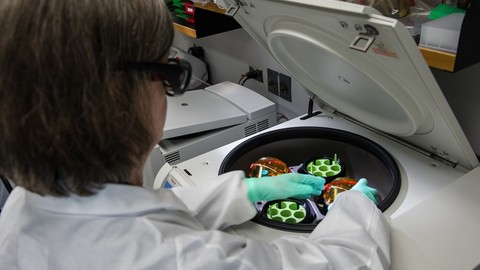
Carbohydrate and Lipid MCQ Practice (Bio Chemistry)
-
Carbohydrate -
Lipid
- Anyone who wants to learn Bio Chemistry
- Advanced Bio Chemistry
- Carbohydrate
- Lipid
A carbohydrate is a biomolecule consisting of carbon (C), hydrogen (H) and oxygen (O) atoms, usually with a hydrogen–oxygen atom ratio of 2:1 (as in water) and thus with the empirical formula Cm(H2O)n (where m may be different from n). This formula holds true for monosaccharides. Some exceptions exist; for example, deoxyribose, a sugar component of DNA, has the empirical formula C5H10O4. The carbohydrates are technically hydrates of carbon; structurally it is more accurate to view them as aldoses and ketoses
The term is most common in biochemistry, where it is a synonym of saccharide, a group that includes sugars, starch, and cellulose. The saccharides are divided into four chemical groups: monosaccharides, disaccharides, oligosaccharides, and polysaccharides. Monosaccharides and disaccharides, the smallest (lower molecular weight) carbohydrates, are commonly referred to as sugars. While the scientific nomenclature of carbohydrates is complex, the names of the monosaccharides and disaccharides very often end in the suffix -ose, as in the monosaccharides fructose (fruit sugar) and glucose (starch sugar) and the disaccharides sucrose (cane or beet sugar) and lactose (milk sugar)
In biology and biochemistry, a lipid is a macrobiomolecule that is soluble in nonpolar solvents. Non-polar solvents are typically hydrocarbons used to dissolve other naturally occurring hydrocarbon lipid molecules that do not (or do not easily) dissolve in water, including fatty acids, waxes, sterols, fat-soluble vitamins (such as vitamins A, D, E, and K), monoglycerides, diglycerides, triglycerides, and phospholipids
The functions of lipids include storing energy, signaling, and acting as structural components of cell membranes. Lipids have applications in the cosmetic and food industries as well as in nanotechnology
These questions will give you basic idea for Examination Preparation and/or interview on Carbohydrate and Lipid.
Please Note:
- These questions are only for practice and understanding level of knowledge only. It is not necessary that these questions may or may not appear for examinations and/or interview questions
- In this practice test, because of large amount of questions (around 86 questions) some of questions may have repeated
- I had to put as 70% pass rate because there may also be wrong answers from my side
- Bio Chemistry
- Carbohydrate
- Lipid






